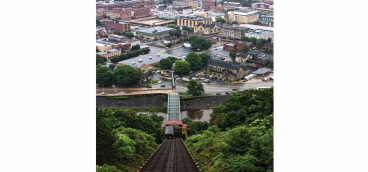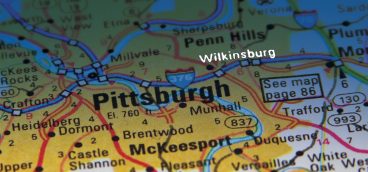Infrastructure Bonanza

It promises to be a busy couple of years for Vincent Valdes. As the federal government begins to pump $1.2 trillion into the nation’s infrastructure, the Southwestern Pennsylvania Commission he leads is in the thick of discussions around how to spend the region’s share, which will be counted in hundreds of millions of dollars and possibly much more. It includes large sums for roads, bridges and public transit and new money for infrastructure that saw little financing before. Never has so much money been available to bring broadband internet to Pennsylvanians who don’t have it, which one study suggests could be as much of half of the state.
“I think we are living through a once-in-a-lifetime opportunity,” Valdes said.
Pennsylvania can expect to get at least $18 billion from the Infrastructure Investment and Jobs Act passed with bipartisan support in Congress and signed into law by President Joe Biden in November. Most of that money will be allocated through existing formulas. But regions could also tap into billions of additional dollars available through competitive grants.
It isn’t a stimulus package, such as the 2009 American Reinvestment and Recovery Act passed to lift the country out of recession by quickly pushing out money to local projects that were ready to go. The larger and broader Infrastructure Investment and Jobs Act is a longer-term approach toward strengthening U.S. competitiveness through infrastructure with an eye on spreading the benefits to a wide swath of people and places.
Managing that kind of investment is a huge undertaking, which largely rests on the shoulders of state and local governments, which own most of the infrastructure. But they aren’t starting from scratch. In southwestern Pennsylvania, officials have decades of studies and long-range plans in hand that inventory regional needs and set priorities. Discussions on how to advance those plans with the new infrastructure dollars have been underway for months. And the January collapse of the Fern Hollow Bridge in the City of Pittsburgh underscores the urgency of addressing the deterioration of infrastructure that people in the region depend on daily.
PLENTY OF NEED
The Southwest Planning Commission has convened officials from 10 southwestern Pennsylvania counties around infrastructure issues for 60 years as the region’s federally funded metropolitan planning organization. Its short- and long-term plans show how badly the new money is needed.
SPC reported in 2019 that anticipated government funding in the coming years will cover less than half of the cost of keeping the region’s roads and bridges in their current condition and warned that without additional money, “transportation system performance will deteriorate.”
Pennsylvania is expected to receive more than $11 billion in formula-based funding for roads and highways, $1.6 billion for bridge replacement and repair and $2.8 billion for public transit.
How much of the state’s share will flow to southwestern Pennsylvania won’t be clear for months or longer. But much of the transportation money is based on existing formulas, allowing planners to estimate the region’s share.
The 10-county region is expected to see about $500 million more in highway and bridge formula funding alone over the next four years, the SPC estimates. “It essentially boosts our highway and bridge program by about one-third,” said Andy Waple, SPC’s director of transportation planning.
The money allows for restoring the health of poor roads and bridges and doing more preventive maintenance to keep those that are in good condition from falling into costly states of disrepair. At the same time, regions can compete for more than $100 billion in discretionary grants that could help turn long-dreamed-of big-ticket projects into reality.
Those competitive grants cover a range of infrastructure, from public transit, highways, roads and bridges to energy, broadband and airports. “This is head and shoulders more funding than I’ve seen come through discretionary programs in the past,” said Valdes, a former the U.S. Department of Transportation administrator. “It’s an exciting proposition.”

For transportation alone, the pool of grant money is substantial. Regions can compete for $12.5 billion in national funding for bridges considered critical to local economies and another $16 billion in grants for major projects that deliver significant economic benefits to communities.
The best candidates will likely be those that are already widely embraced as good ideas in the region and have undergone some planning, but are on the shelf, or have been slow to develop, due to a lack of funding.
One example is the Port Authority of Allegheny County’s proposed extension of the East Busway. “There have been feasibility studies. But it’s one of those big projects that you’re not going to be able to pay for with formula money,” Waple said. “It’s going to take one of these discretionary pots to bring that to fruition.”
Butler County officials consider a 26-mile stretch of Route 228 a critical, but outdated, corridor serving some the region’s fastest growing communities. Plans call for spending $270 million to improve its capacity in stages. About $100 million of the work remains to be done. An expensive project in Pittsburgh that city and Allegheny County officials consider critical is widening Bates Street and making other improvements to the corridor linking the city’s research universities to its Hazelwood neighborhood, where a technology hub is taking root.
The region has assets that make it a strong competitor for grants across a range of sectors, said Matt Smith, president of the Greater Pittsburgh Chamber of Commerce. The region’s research universities are one. Its core of innovative companies, talent pool and growing energy industry are others. And the federal government has made major investments in the region recently that suggest it is seen as a place for innovation, including $250 million to establish the Advanced Robotics in Manufacturing Institute in Pittsburgh.
“Carnegie Mellon is a world leader in the autonomous mobile systems sector. When we compete for a smart transportation grant that could provide support for traffic signal synchronization and smart mobility networks, we are going to have a strong argument that [the region] is a smart investment because of CMU, the talent pipeline and the companies we have here,” Smith said. “In the energy space, because we have a robust natural gas supply and reservoir, we’re in a good position to compete for some of the carbon-capture technology grants.”
Still, winning discretionary grants won’t be easy, Valdes said. “I can tell you from being on the inside, they’re very competitive and they’re always over-subscribed. It’s important to articulate what you expect to achieve with the money, how ready you are to manage the money responsibly and that you have consensus and support, both from the community and political leadership.”
A LONG REACH
The breadth of the infrastructure act is one of its most striking characteristics. It boosts funding for nearly every sector of infrastructure. Its impact should be felt in urban and rural municipalities alike. And it includes programs for low-income families and communities to share some of the benefits.
Besides large capital outlays for roads, bridges and public transit, there is more than $65 billion over five years for improving rail services across the country and $25 billion to upgrade airports. Some $55 billion is available for water infrastructure, including $15 billion to replace lead service lines.
Another $65 billion will be invested in the nation’s energy infrastructure, including money to improve grid reliability and for climate-change technologies, such as carbon capture. More than $4 billion is available for plugging orphaned oil and gas wells — a costly problem in Pennsylvania, where the Department of Environmental Resources estimates the number of such wells could be as high as 200,000. The act also creates a national carbon-reduction program with more than $6 billion for local projects, such as bus rapid transit, intelligent transportation systems, and infrastructure for bicycling and walking.
Some $2 billion in grants are available for surface transportation systems in rural communities and $1 billion to reconfigure highways that cut through urban neighborhoods creating barriers to mobility and economic development. The act provides $1.2 billion for brownfield development. It spends more than $47 billion to improve resiliency, including money to enhance state and local cybersecurity and a $3.5 billion weatherization program to reduce home energy costs.
The nation’s ports and inland waterways get more than $16 billion in upgrades. In southwestern Pennsylvania, where the region’s three working rivers contribute an estimated $5 billion to the local economy, funding shortfalls have slowed the maintenance and replacement of locks, dams and other infrastructure, much of which is 70-80 years old.
Pennsylvania also will get a share of the $65 billion set aside for improving access to broadband internet nationwide. Broadband is increasingly seen as a critical service with the speed to handle bandwidth-hungry tasks that working, learning and being entertained remotely demand.
Federal Communications Commission maps based on self-reported data from internet service providers suggest 100 percent broadband availability across Pennsylvania. But a recent study suggests that is wildly optimistic. After 11 million field tests, Penn State researchers reported that median speeds across most areas of the state do not reach the FCC’s minimum broadband standard. In no county is true broadband available to more than half of the population and speeds tend to be much slower in rural areas.
Availability is not the only barrier. In some places, broadband might be available, but too expensive for some. Each state is guaranteed at least $100 million in new infrastructure money. Pennsylvania is likely in line to receive much more to support everything from building out broadband infrastructure to providing low-income families with vouchers to help them afford it.
“This kind of money for broadband has never been seen before,” said Karen Lightman, executive director of CMU’s Metro 21: Smart Cities Institute, which is helping SPC determine local broadband needs and solutions. “It’s exciting. We don’t even know what’s possible when so many people who’ve been disconnected get connected.”
There is little question that an initiative the size of the Infrastructure Investment and Jobs Act has the potential to prepare southwestern Pennsylvania for a more connected, resilient and competitive future. Federal officials now face the daunting challenge of moving more than $1 trillion out the door through hundreds of programs. It will then be up to state and local officials to make the decisions that will determine whether the investment lives up to its promise.















